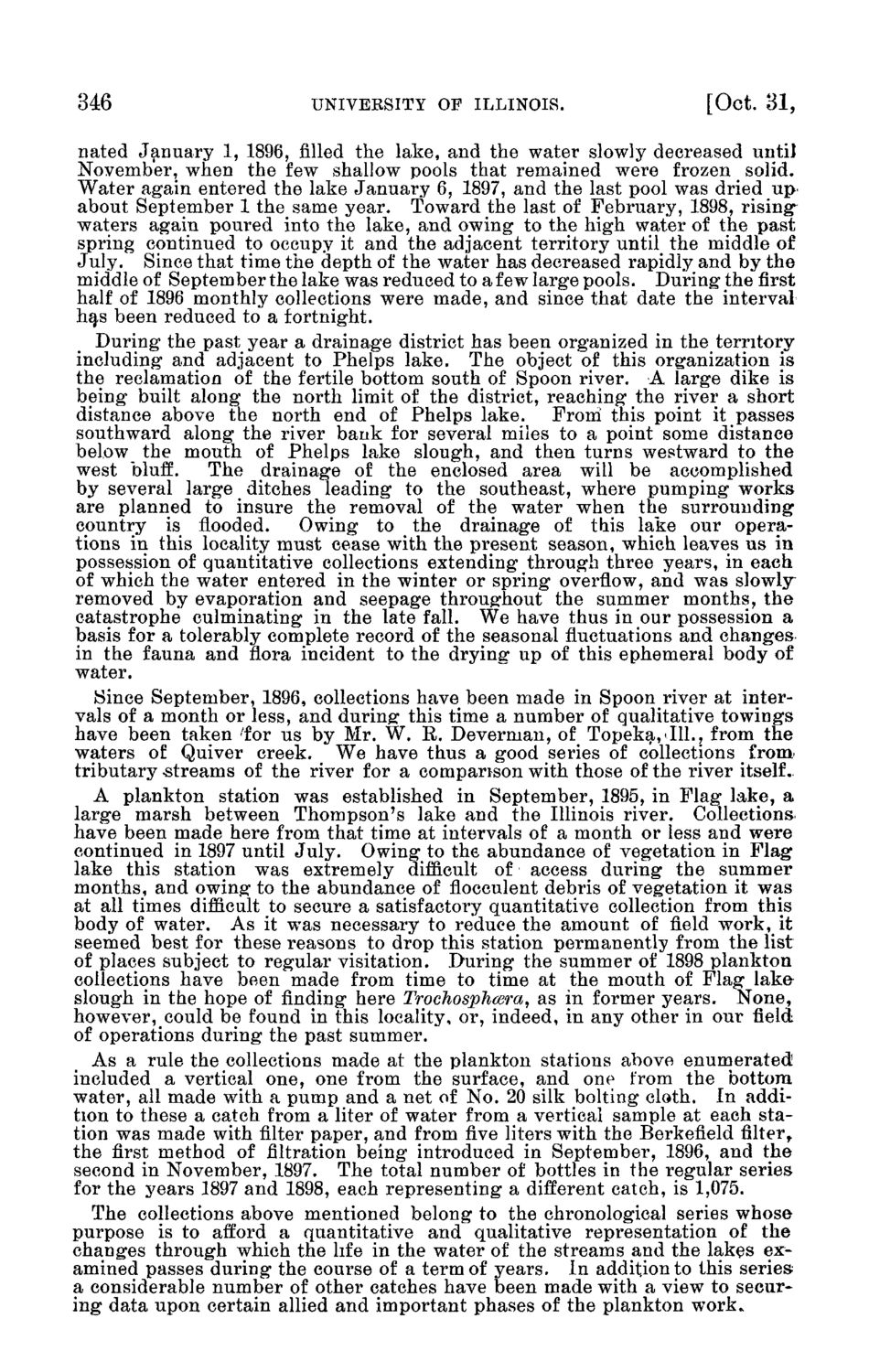| |
| |
Caption: Board of Trustees Minutes - 1898
This is a reduced-resolution page image for fast online browsing.

EXTRACTED TEXT FROM PAGE:
346 UNIVERSITY OF ILLINOIS. [Oct. 3 1 , nated January 1, 1896, filled the lake, and the water slowly decreased until November, when the few shallow pools that remained were frozen solid. Water again entered the lake January 6, 1897, and the last pool was dried up about September 1 the same year. Toward the last of February, 1898, risings waters again poured into the lake, and owing to the high water of the past spring continued to occupy it and the adjacent territory until the middle of July. Since that time the depth of the water has decreased rapidly and by the middle of September the lake was reduced to a few large pools. During the first half of 1896 monthly collections were made, and since that date the interval has been reduced to a fortnight. During the past year a drainage district has been organized in the territory including and adjacent to Phelps lake. The object of this organization is the reclamation of the fertile bottom south of Spoon river. A large dike is being built along the north limit of the district, reaching the river a short distance above the north end of Phelps lake. From this point it passes southward along the river bank for several miles to a point some distance below the mouth of Phelps lake slough, and then turns westward to the west bluff. The drainage of the enclosed area will be accomplished by several large ditches leading to the southeast, where pumping works are planned to insure the removal of the water when the surrounding country is flooded. Owing to the drainage of this lake our operations in this locality must cease with the present season, which leaves us in possession of quantitative collections extending through three years, in each of which the water entered in the winter or spring overflow, and was slowly removed by evaporation and seepage throughout the summer months, the catastrophe culminating in the late fall. We have thus in our possession a basis for a tolerably complete record of the seasonal fluctuations and changes in the fauna and flora incident to the drying up of this ephemeral body of water. Since September, 1896, collections have been made in Spoon river at intervals of a month or less, and during this time a number of qualitative towings have been taken 'for us by Mr. W. R. Deverman, of Topeka, J11.2 from the waters of Quiver creek. We have thus a good series of collections from. tributary -streams of the river for a comparison with those of the river itself. A plankton station was established in September, 1895, in Flag lake, a large marsh between Thompson's lake and the Illinois river. Collections, have been made here from that time at intervals of a month or less and were continued in 1897 until July. Owing to the abundance of vegetation in Flag lake this station was extremely difficult of access during the summer months, and owing to the abundance of flocculent debris of vegetation it was at all times difficult to secure a satisfactory quantitative collection from this body of water. As it was necessary to reduce the amount of field work, it seemed best for these reasons to drop this station permanently from the list of places subject to regular visitation. During the summer of 1898 plankton collections have been made from time to time at the mouth of Flag lake slough in the hope of finding here Trochosphcera, as in former years. None, however, could be found in this locality, or, indeed, in any other in our field of operations during the past summer. As a rule the collections made at the plankton stations above enumerated included a vertical one, one from the surface, and one from the bottom water, all made with a pump and a net of No. 20 silk bolting cloth. In addition to these a catch from a liter of water from a vertical sample at each station was made with filter paper, and from five liters with the Berkefield filter, the first method of filtration being introduced in September, 1896, and the second in November, 1897. The total number of bottles in the regular series for the years 1897 and 1898, each representing a different catch, is 1,075. The collections above mentioned belong to the chronological series whose purpose is to afford a quantitative and qualitative representation of the changes through which the life in the water of the streams and the lakes examined passes during the course of a term of years. In addition to this series a considerable number of other catches have been made with a view to securing data upon certain allied and important phases of the plankton work.
| |